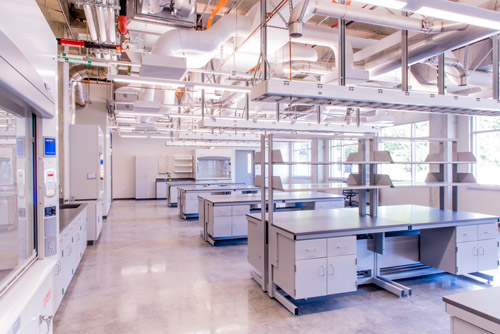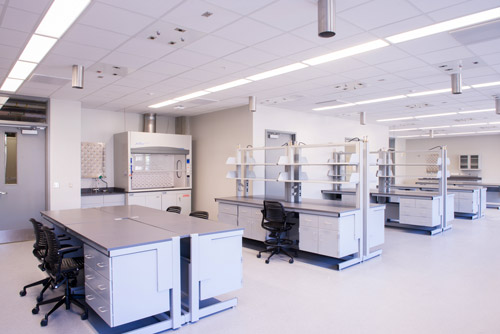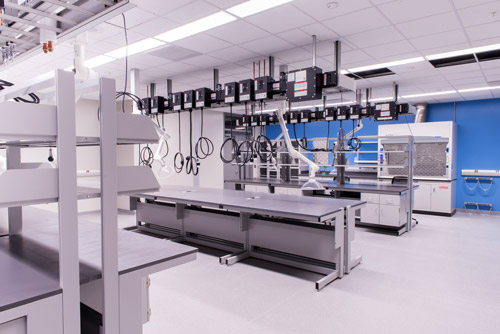A well-engineered success story: KU's expansion project
Excerpts only: The full original article, "A well-engineered success story" by Jessica Burdg was published in Lab Design News on August 17, 2016.

The University of Kansas (KU) in Lawrence is a school known for its commitment to students, faculty and the community. Thanks to a recently completed expansion project, the School of Engineering is now better able to fulfill that commitment to its current and future engineering and computing students and faculty. The $105 million dollar project added 185,000 square feet of new construction and renovated existing structures to become a truly well-engineered success story for the university.
Graduating Game Changers
The success of its academic programs has never been an enrollment-only numbers game for KU. Nonetheless, KU Engineering’s goal was to increase the number of engineering graduates by more than 60 percent by 2021.
"You can increase enrollments all you want, but the School of Engineering took a different approach," Professor Robert Parsons, Director of Construction for the Engineering Expansion Project, said. "KU looked at these numbers and said, 'yes, we need to do more.' We want to support our students so they have everything they need to succeed and feel at home here."
That attitude, Parsons said, helps with both recruitment and retention.
Michael S. Branicky, KU's Dean of Engineering since 2013, said he believes the overarching goal of this project was to help graduates continue to go on to be leaders and innovators who affect the state, the country and the world.
"We have KU graduates everywhere from the aerospace industry to the headquarters of Uber. It's this real world notion that you're both learning and learning for a purpose," Branicky said. "For that, we know we need excellent faculty and an excellent facility."
. . . .

Design Delivers New Collaborative Learning Spaces and State of the Art Laboratories
The first phase of the project, the construction of the Measurement, Materials and Sustainable Environment Center (M2SEC), was primarily funded by a grant from the National Institute of Science and Technology (NIST) with a goal of promoting thematically based projects like materials characterization, sustainable building practices and alternative fuels research. Today, the building is a hotbed for innovation, including two "living walls" that monitor environmental change and a space to grow algae on the roof so that it can be compressed and refined to produce biofuels.
. . . .
Completed in Fall 2015, another critical component to the engineering expansion was the construction of the Learned Hall Engineering Expansion Phase 2 (LEEP2) building, which was built as a literal and figurative bridge between the existing engineering facility and the newly constructed M2SEC building.
LEEP2 boasts six active learning classrooms that hold 60 to 160 students. In these innovative spaces, students are engaged in small groups or complete collaborative work more often, thanks in part to a commitment to eliminate tiered or sloped floor classrooms like those often seen in traditional lecture halls...
. . . .
Besides classrooms, LEEP2 has a number of teaching laboratories—over 11,500 square feet of them, to be exact—including spaces specialized for instrumentation, environmental engineering, building thermal science and more. Nearly 17,000 square feet is dedicated to research laboratories, such as those for analytical chemistry and bioengineering. LEEP2's laboratories feature a variety of state of the art laboratory equipment, including 34 Protector XStream High Efficiency Fume Hoods.
. . . .

Overcoming Challenges
Like any laboratory design or construction project, the KU Engineering Expansion did not come without its unique set of challenges. For instance, LEEP2 is sandwiched between three existing buildings—including the recently completed M2SEC. A key challenge of the design team was to join all these spaces to produce a cohesive environment that had adequate natural light.
. . . .
A Sustainable, Welcoming Space
LEEP2 adds something else already prevalent among the many buildings across KU's campus: efficiency. The university mandates that their facilities exceed ASHRAE 90.1, and this project did by a minimum of 30 percent. To satisfy this goal, LEEP2 employs the use of heat recovery chillers, energy recovery systems, low VOC adhesives and paints, and a rainwater collection system that pipes fresh water into restrooms.
. . . .
"Prospective students and faculty come in and they see the facilities, the research labs that are very hood-intensive but also very reconfigurable, and they want to stay here," Dean Branicky said. "We've been able to recruit people specifically because of the quality of the laboratory space."
| chevron_left | 93 year old Yale building gets over 150 new ClassMate fume hoods | Articles | Freeze dryer accessories make life (and lyo) easier | chevron_right |






